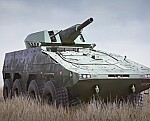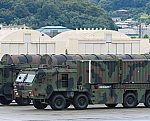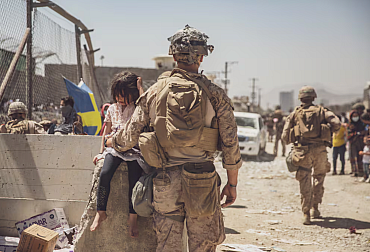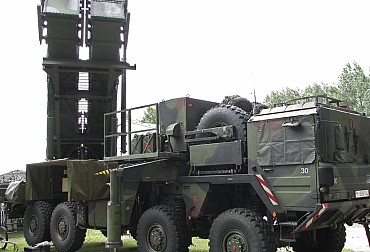Russian paratrooper BMD-2 and BRT-D vehicles overhauled and modernised
Russian defence holding company Rostezh has announced the handover of another batch of BMD-2 Infantry Fighting Vehicles (IFV) and BRT-D Armoured Personnel Carriers (APC) to the VDV units (Airborne Forces). The vehicles have been overhauled and partially modernised.
The 144th Tank Repair Workshop and the Volgograd branch of the Kurganmashzavod plant are to be responsible for the repair and modernisation work. The scale of the modernisation work on the vehicles has not been specified, although in the case of the BMD-2 it may be assumed that its standard will be upgraded to the M version. In December 2018, the Russian Ministry of Defence announced its desire to thoroughly modernise around 600 BMD-2 infantry fighting vehicles of the Airborne Forces to the BMD-2M standard, and the work was to start in 2021. It is therefore possible that the transferred vehicles are part of the aforementioned plans from years ago. Otherwise, they are most likely simple overhauls combined with minor replacement of components no longer in production.
The BMD-2 Infantry Fighting Vehicle
The BMD-2 is a Russian armoured Infantry Fighting Vehicle designed for airborne units. It was developed in the Soviet Union in the early 1980s by VTZ of Volgograd. The BMD-2 entered service in 1985. The BMD-2 was developed from the BMD-1 chassis. It has a new weapon system with a single-seat turret armed with a 2A42 30mm cannon and a PKT 7.62mm coaxial machine gun, identical to the BMP-2 armoured Infantry Fighting Vehicle. For anti-tank warfare, it is equipped with a system capable of firing the 9M111 Fagot AT-4 or 9M113 Konkurs AT-5 anti-tank missiles.

The fuselage and turret are made of 7–15 mm thick aluminium alloys. The propulsion of the BMD-2, which weighs 11.5 tonnes, is provided by a 5D-20 diesel engine with 241 hp, allowing it to accelerate to 80 km/h on a paved road, move at about 40 km/h off road, and up to 10 km/h when traversing water obstacles by swimming. The crew is two people, while the vehicle can transport up to six soldiers.
The BMD-2 can be parachuted from Antonov An-12 and Ilyushin Il-76 transport aircraft. It is fitted with active suspensions that vary from 100 mm in the parachute position to 450 mm in the off-road position. The chassis is fitted with a 7.62 mm machine gun. The BMD-2 is the main armoured fighting vehicle used by Russian airborne units, with nearly a thousand currently in service. The BMD-2 is also used by the armed forces of Ukraine and Uzbekistan.
The vehicle has been used several times in combat, notably during the final stages of the war in Afghanistan, the war in Chechnya, the conflict in South Ossetia in 2008 and, finally, the current conflict in Ukraine, where several examples have been deployed by both sides.
On 29 September 2017, the Russian Ministry of Defence signed a contract to modernise 540 BMD-2 and BMP-2 armoured infantry fighting vehicles. The armoured vehicles will receive a two-seat Berejok turret, armed with a 2A42 30mm cannon, a PKTM 7.62mm coaxial machine gun, an AG-17M 30mm automatic grenade launcher and 2×2 Kornet anti-tank missile launchers. The Berejok turret is fitted with new-generation thermal imaging scopes for the gunner and gunner. The upgrade is part of the 2018–2025 military equipment procurement programme.
Armament
- Main Gun: 30 mm 2A42 x100.2 calibre
- 2 machine guns: 7.62 mm PKT
- Missiles: 9M111 Fagot/AT-4 Spigot, 9M113 Konkurs/AT-5 Spandrel
Technical specifications
- Crew: 2 + 6
- Engine: 5D20, 240 hp
- Speed: 80 km/h on road, 40 km/h off road
- Water speed: 10 km/h
- Range: 450 km
- Weight: 8.2 t
Dimensions
- Chassis length: 5.40 m
- Length with barrel: 5.91 m
- Width: 2.63 m
- Height: 1.61 to 1.96 m
The BMD-2 prececessor was the BMD-1, developed in the Soviet Union in the early 1960s by VTZ of Volgograd. The BMD-1 entered service in 1969. Used by paratroopers and air assault units, also the BMD-1 was designed to be parachuted from transport aircraft. It weighed less than 8 tonnes and could be parachuted from Antonov An-12 aircraft using the PRSM-925 Reaktavr parachuting system. Its armour protects against small-calibre weapons.
The BMD-1's main armament was derived from the armament of the BMP-1 armoured Infantry Fighting Vehicle, which entered service in 1966. The single-seat turret was armed with a 2A28 Grom 73mm cannon, a PKT 7.62mm coaxial machine gun and a 9M14 Malyutka/AT-3 Sagger anti-tank missile. The BMD-1P version, which entered service in 1977, was fitted with the 9M111 Fagot/AT-4 Spigot and 9M113 Konkurs/AT-5 Spandrel anti-tank missiles.
The engine was mounted at the rear of the chassis for optimum weight balance. The cockpit was at the front centre of the chassis. The vehicle carried two crew members, a driver and a gunner, as well as a group of five infantrymen, two of whom were positioned on either side of the driver. The BMD-1 was replaced by the BMD-2 from 1985.
The BTR-D Armoured Personnel Carrier
The BTR-D is a Russian Armoured Personnel Carrier designed for airborne units. It was developed in the Soviet Union in the early 1970s by VTZ of Volgograd. The BTR-D entered service in 1974. The BTR-D is based on the chassis of the BMD-1 Infantry Fighting Vehicle and offers greater internal volume for the installation of various equipment and weapons systems. The chassis was lengthened by 483 mm and changed from five to six rollers. Like the BMD-1, the BTR-D has active suspension that varies from 100 mm in the drop position to 450 mm in the off-road position.
The BTR-D has no turret and can be fitted with one or two 7.62 mm machine guns. Amphibious, it is propelled in water by two waterjets. The BTR-D was never exported outside the Soviet Union after the dissolution of the USSR, but remained in service in Russia, Belarus, Ukraine, Moldova and Uzbekistan. The BTR-D chassis was used for various armoured vehicles.
Armament
2 machine guns: 7.62 mm PKT
Technical specifications
- Crew: 1 + 12
- Engine: 5D20, 240 hp
- Speed: 62 km/h
- Water speed: 10 km/h
- Range: 500 km
- Weight: 8 t
Dimensions
- Chassis length: 5.88 m
- Width: 2.63 m
- Height: 1.65 to 2.00 m










